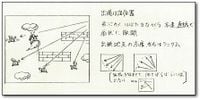List of Super Mario Bros. pre-release and unused content: Difference between revisions
Tag: Mobile edit |
Tag: Mobile edit |
||
| Line 10: | Line 10: | ||
The game was initially divided between ground and sky segments, which had Mario riding a rocket (or a cloud in later stages of development) and shooting enemies.<ref name="Iwata Asks"></ref> The sky-based bonus round of the final game are apparently a remnant of this idea.<ref>[http://www.1up.com/news/super-mario-bros-25th-miyamoto "Super Mario Bros.' 25th: Miyamoto Reveals All"]</ref> | The game was initially divided between ground and sky segments, which had Mario riding a rocket (or a cloud in later stages of development) and shooting enemies.<ref name="Iwata Asks"></ref> The sky-based bonus round of the final game are apparently a remnant of this idea.<ref>[http://www.1up.com/news/super-mario-bros-25th-miyamoto "Super Mario Bros.' 25th: Miyamoto Reveals All"]</ref> | ||
[[Shigeru Miyamoto]] initially wanted Mario to ride a Yoshi in the game, but technical limitations of the NES prevented the concept from being implemented. This idea eventually evolved into [[Yoshi]], who was able to be introduced in ''[[Super Mario World]]'' for the more powerful [[Super Nintendo Entertainment System]]. | [[Shigeru Miyamoto]] initially wanted Mario to ride a [[Yoshi]] in the game, but technical limitations of the NES prevented the concept from being implemented. This idea eventually evolved into [[Yoshi]], who was able to be introduced in ''[[Super Mario World]]'' for the more powerful [[Super Nintendo Entertainment System]]. | ||
The development sketches included in ''[[Super Mario All-Stars Limited Edition]]'' show that the game initially had screen-by-screen scrolling (similar to the later-released ''[[Super Mario Bros. Special]]'') rather than continuous scrolling as in the final version.<ref>[http://www.glitterberri.com/super-mario-bros/mario-development-notes/ "Mario Development Notes"]</ref> | The development sketches included in ''[[Super Mario All-Stars Limited Edition]]'' show that the game initially had screen-by-screen scrolling (similar to the later-released ''[[Super Mario Bros. Special]]'') rather than continuous scrolling as in the final version.<ref>[http://www.glitterberri.com/super-mario-bros/mario-development-notes/ "Mario Development Notes"]</ref> | ||
Revision as of 14:51, March 22, 2020
This is a list of pre-release and unused content for the game Super Mario Bros..
Early iteration
The development of Super Mario Bros. began with a 16x32 pixel square used as a placeholder, which couldn't jump at all and moved about a single screen. After taking notice of the sales figures for Mario Bros., Tezuka proposed the idea of using Mario for the game to Miyamoto, which was accepted.[1] Visible checkpoints were considered in development.[citation needed]
The game was initially far more focused on shooting than platforming. Mario could carry weapons (with a rifle and a "beam gun" mentioned as being usable),[2] and the control scheme was different; the up arrow of the was used to jump, while pressing
used whatever item Mario carried or kicked when empty-handed.[2]
The game was initially divided between ground and sky segments, which had Mario riding a rocket (or a cloud in later stages of development) and shooting enemies.[2] The sky-based bonus round of the final game are apparently a remnant of this idea.[3]
Shigeru Miyamoto initially wanted Mario to ride a Yoshi in the game, but technical limitations of the NES prevented the concept from being implemented. This idea eventually evolved into Yoshi, who was able to be introduced in Super Mario World for the more powerful Super Nintendo Entertainment System.
The development sketches included in Super Mario All-Stars Limited Edition show that the game initially had screen-by-screen scrolling (similar to the later-released Super Mario Bros. Special) rather than continuous scrolling as in the final version.[4]
- Smb control scheme.jpg
The original control scheme.
Early builds
Ending theme
Koji Kondo originally composed the ending theme with an AABA structure, but, since the song would take up too much memory, the "B" portion was cut. The original version of the ending theme was later used for the Famicom Disk System version of Super Mario Bros.: The Lost Levels.[5]
